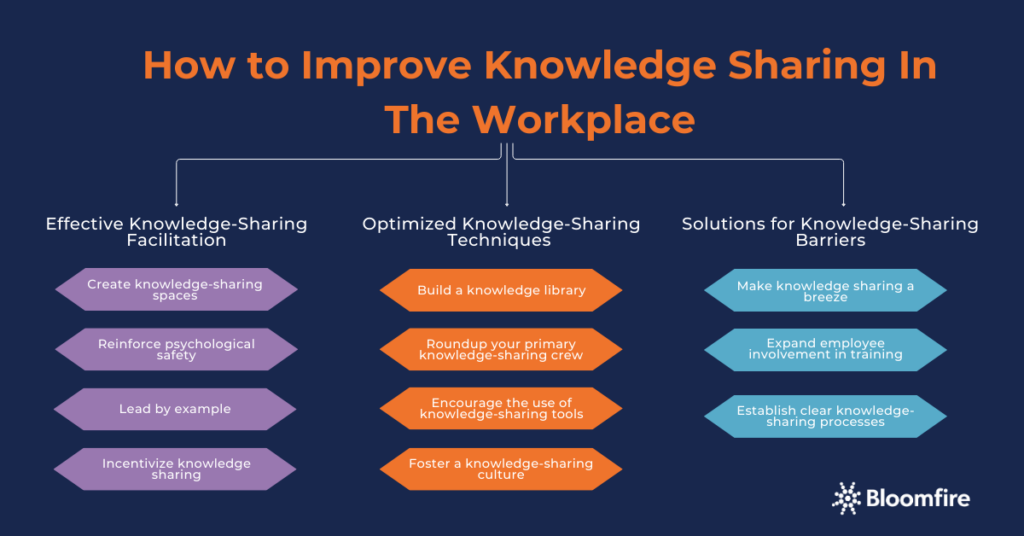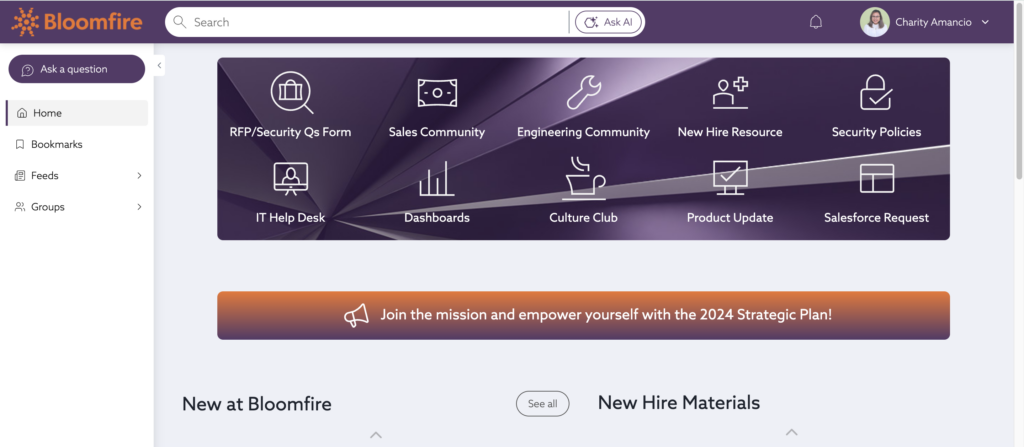11 Ways to Improve Knowledge Sharing in the Workplace

In many companies, knowledge sharing is overlooked simply because it is not part of employees’ daily routines or because they are unsure how they will benefit from sharing knowledge. Understandably, team members often focus all of their efforts on completing their core responsibilities rather than spending time inputting information into a knowledge base. However, with the increasing expansion of digital workspaces, the value and urgency of a swift knowledge-sharing process and culture cannot be ignored.
To encourage knowledge management (KM) and dissemination regularly, employing some of the most effective tips and techniques to improve knowledge sharing is imperative. These recommendations often include ensuring psychological safety at work, implementing a systematic reward system, providing tools and training, incorporating knowledge-sharing in your company’s culture, and more.
Importance of a Streamlined Knowledge-Sharing at Work
Constant knowledge sharing in the workplace brings a multitude of benefits to organizations, especially where remote work and geographically dispersed teams are increasingly common. An effective knowledge-sharing system and KM strategies drive the following outcomes:
- Increases interaction in the workplace (even between remote teams)
- Leads to a rise in creative problem-solving and improved productivity
- Mitigates knowledge loss as employees retire or move on
- Breaks knowledge hoarding and reduces redundancy
- Enables employees to readily access the information they need, regardless of their location or time zone
- Enhances overall business agility
A Dedicated KM Platform for Knowledge Sharing
Using Bloomfire to protect and leverage your intellectual assets can ingrain a knowledge-sharing culture in your organization.
Schedule a Demo
How you plan and execute your program may determine whether you aim to improve knowledge sharing. Below are the best ways to imprint a culture of information sharing across your workspace, divided into three categories: pragmatic facilitation, proven techniques, and ways to overcome barriers.

Tips for Effective Knowledge-Sharing Facilitation
For your employees to engage consistently in sharing knowledge across departments, you must create an environment where individuals feel comfortable and motivated to both impart their expertise and learn from others. This can be achieved through the following actions:
1. Create knowledge-sharing spaces
Whether you and your team work from the same office, are fully remote, or have adopted a hybrid work model, it’s important to establish physical and virtual spaces conducive to workplace knowledge sharing. You’ll want to consider:
a. Spaces for real-time collaboration
Provide employees with appropriate tools and spaces to facilitate real-time collaboration. Physical offices should include dedicated meeting rooms, while remote or hybrid teams require platforms like Zoom, Slack, Microsoft Teams, or Miro to enable virtual collaboration. This empowers employees to brainstorm, contribute to projects, and engage in group activities effectively.
b. Spaces for asynchronous collaboration
Real-time collaboration may not always work, primarily when team members work from different locations on different schedules. Provide employees tools for asynchronous collaboration–a setup that continues to gain traction, prompting productivity by 2-3.5 hours. This move ensures that people can share knowledge even when their calendars don’t align.
For example, employees can record video presentations summarizing projects or conference learnings. Then, they can share the video on a knowledge management platform so their colleagues can watch it when they have time.
c. Spaces for team building
Team-building activities foster interpersonal connections among colleagues, cultivating trust and psychological safety conducive to knowledge sharing. In fact, 63% of leaders claim that communication among employees improves after participating in these activities.
While in-person activities are common, virtual alternatives can effectively translate these benefits to remote teams. These include posting icebreaker questions, using informal communication channels, and sharing personal interests.
Virtual team building also promotes a collaborative environment where knowledge exchange is encouraged and valued. For example, teams might start virtual meetings with an icebreaker question, talk with co-workers in a “watercooler” Slack channel, or share pictures of their pets or home office setups.

Remote workers can leverage virtual team-building activities to encourage knowledge-sharing across departments.
Bonus Tip: Set up a conducive physical layout for knowledge-sharing spaces
Consider how office layout influences collaboration and knowledge sharing amongst team members. Thoughtful space design can foster a collaborative environment without requiring extensive renovation. Prioritize elements that encourage interaction and knowledge exchange. Here are a few examples of easy fixes to make your office space social-friendly:
- Coffee stations: Set up several coffee stations throughout the office, rather than just in the kitchens. Nothing has the power to bring folks together as coffee does, and having multiple coffee stations throughout the office will encourage people to speak to co-workers they may not usually interact with while they wait for their pour-over to brew.
- Conference rooms: Consider diversifying conference room layouts beyond the traditional single, large table format. While suitable for certain meetings, alternative configurations with smaller tables, clustered seating, and comfortable furniture can foster a less formal atmosphere. This can be more conducive to collaborative discussions and creative brainstorming.
- Casual seating in common spaces: Implementing casual seating in high-traffic areas encourages impromptu workplace interactions. This fosters a more communicative and collaborative work environment, promoting the organic exchange of ideas and knowledge.
Creating an environment that encourages interaction and provides opportunities for casual exchanges will boost communication and foster a more vibrant and innovative workplace culture. Remember that a well-designed workspace can be a powerful tool for unlocking your team’s collective intelligence and potential.
2. Reinforce psychological safety
Effective knowledge-sharing facilitation goes beyond simply providing platforms and tools. It requires fostering a culture of open communication and psychological safety–a work factor that 84% of employees value the most. Your management team must create an environment where employees feel comfortable sharing their expertise, asking questions, and even admitting mistakes without fear of judgment or negative repercussions.
Imagine a workplace where employees are encouraged to share lessons learned from previous roles or suggest improvements to existing processes. A new employee, bringing fresh perspectives from a different company, might propose a more efficient approach to project management. In a psychologically safe environment, this suggestion would be welcomed and explored, potentially leading to positive change.
3. Lead by example
Leaders play a crucial role in fostering a knowledge-sharing environment by exemplifying the desired behaviors. Actively sharing expertise, providing positive reinforcement for contributions, and transparently communicating the benefits of knowledge management initiatives are essential in this endeavor. For instance, if you have a centralized knowledge-sharing platform, consider regularly publishing video updates or write-ups–put your leaders in the forefront.
It’s also important to be transparent and clarify why you’re creating a knowledge management framework. Illustrate the positive impact of knowledge sharing with concrete examples of how it has contributed to project success and organizational goals. If people understand how their work will contribute to a larger project, they will feel more valued and motivated to offer creative and insightful solutions.
4. Incentivize knowledge sharing
A well-structured reward system reinforces the value of shared expertise and encourages active participation in knowledge exchange. Recognizing and incentivizing employee contributions to knowledge-sharing initiatives fosters a collaborative and innovative work environment. The incentives you offer should represent your unique company and culture, but some ideas might include:
- Public recognition: Recognize and encourage employees by providing a shoutout in an email, post, or announcement highlighting a team member’s contribution to the company’s knowledge base. Highlight the content shared and its tangible benefits to the organization, fostering a culture of knowledge sharing and recognition.
- Tangible prizes: Give small prizes like company swag or gift cards to reward employees who demonstrate excellent collaboration skills. Consider giving a bonus to the employee who shares the most highly utilized content every quarter or every year.
- Knowledge-sharing events: Organize dedicated events where employees can actively contribute to the organization’s knowledge base. These events should be designed to be engaging and productive, such as providing a catered lunch while employees update documentation or create new resources.
- Professional development: Integrate knowledge dissemination metrics into performance evaluations and promotion criteria, explicitly recognizing its impact on career advancement and organizational success. This practice can improve knowledge sharing as it reinforces the value of shared knowledge and encourages wider participation.
Power Move: Aside from incentives, a great way to foster a knowledge-sharing community and culture is to integrate it into performance expectations and evaluations. Utilize knowledge management platforms to establish clear contribution guidelines, such as regular document updates or weekly engagement. Define specific, measurable, attainable, and relevant key performance indicators (KPIs) to assess knowledge-sharing activities.
Optimized Knowledge-Sharing Techniques
Proven knowledge-sharing techniques will help you encourage active information dissemination throughout your organization. The following techniques center around tools—like an internal knowledge base—and incorporate knowledge-sharing processes that management can use to integrate collaboration daily.
5. Build a knowledge library
As knowledge sharing becomes a part of your company culture, you must prioritize preserving institutional knowledge as a strategic asset. Implementing a readily accessible internal knowledge base is crucial, as well as providing a centralized repository for employees to contribute and retrieve information. Without a robust knowledge management platform—intuitive, searchable, and convenient—any process documentation and knowledge retention efforts will fall flat.
Then, focus on promoting knowledge-sharing activities and processes that make it easy for employees to store documents and capture their subject matter expertise. For instance, you could develop simple templates for team members to document certain types of knowledge, or you could give them the option to capture their knowledge in the medium that makes the most sense to them, whether that’s through a video, slide deck, write-up, or other format.
6. Roundup your primary knowledge-sharing crew
There are likely people in your organization who readily share what they know in various ways—through emails, hallway conversations, messaging apps, and meetings. They aim to help others by documenting and sharing both explicit knowledge (in other words, information that’s easy to articulate and document) and tacit knowledge (expertise gained through experience that’s harder to document).
So, start by identifying those people. See who is already excited about documenting knowledge, and ask them to suggest how and where this content should be shared. Get them involved in your knowledge-sharing initiative, and they will feel more invested in its success and can help champion the effort throughout the organization.
7. Encourage the use of knowledge-sharing tools
Eliminate redundant tasks and information silos by leveraging a knowledge-sharing tool. For example, using a centralized knowledge base empowers employees with self-service access to information, reducing repetitive inquiries and streamlining workflows. This removes time wasted searching disparate sources like Dropbox or Google Docs, fostering efficiency and productivity.
Keep in mind that not all knowledge-sharing tools are created equal. However, the right knowledge management software will allow employees to easily and quickly search for content, ask questions, locate experts, and store documents and videos. Knowledge-sharing platforms also streamline the training and onboarding process and encourage everyone—from interns to CEOs—to contribute ideas.

Bloomfire, a premium knowledge management platform, provides various tools for knowledge sharing.
8. Foster a knowledge-sharing culture
Cultivating a thriving knowledge-sharing culture requires seamless integration into the organizational fabric. Prioritize transparency and accountability by embedding knowledge-sharing into performance expectations and recognizing employees who actively contribute.
Remember that leadership engagement sets a powerful example through regular communication and platform utilization. Plus, it fosters widespread adoption, ultimately strengthening the knowledge-sharing ecosystem for both new and existing employees.
Overcome Knowledge Sharing Barriers
Like any organizational initiative, sharing knowledge in the workplace comes with its own set of challenges. From technological barriers (e.g., your internal knowledge base isn’t convenient or easy to use) to communication barriers (e.g., employees don’t understand the best ways to share ideas or document processes), challenges can and will arise as you implement new knowledge-sharing processes.
Fortunately, however, there are many ways to deal with these issues, which can significantly improve knowledge sharing. These tactics include the following:
9. Make knowledge sharing a breeze
Recognizing that not all employees possess the skills or inclination to effectively document and share knowledge helps you set expectations. However, this can be a challenge in itself. To overcome this hurdle and encourage widespread participation, organizations should proactively eliminate potential barriers.
For instance, pairing hesitant or less experienced employees with skilled colleagues who can assist with knowledge-sharing tasks can facilitate knowledge capture and dissemination. These may include conducting informational interviews, synthesizing existing materials, or creating video demonstrations.
You can also enhance knowledge capture by integrating a question-and-answer tool (general or specific to a group, like a Q&A page for sales teams) within your knowledge management platform. This facilitates efficient information exchange, enabling employees to pose questions and SMEs to provide definitive answers. Consequently, SMEs avoid redundant effort by addressing inquiries once, while the entire organization benefits from the shared knowledge.
10. Expand employee involvement in training
New hires often hesitate to contribute their unique perspectives during the initial onboarding period, potentially hindering the organization from leveraging their valuable skills and knowledge. To mitigate this, organizations should optimize onboarding processes to foster a welcoming and inclusive environment that encourages active participation and collaboration from day one.
Rather than let new hires’ knowledge slide under the radar, use the following suggestions to bolster your onboarding process, improve employee engagement, and encourage employees to contribute and collaborate from their first day.
- Job shadowing: Choose another team member (who is not the new hire’s superior) who exemplifies knowledge sharing and collaboration and allows the new hire to shadow them for a day or two as they work. Observing these individuals allows new employees to gain valuable insights into effective communication, collaborative problem-solving, and knowledge contribution within the team.
- Ask new hires for input: Recognize that new employees possess valuable perspectives and knowledge. Actively solicit their contributions and involve them in developing learning resources, fostering a sense of ownership and confidence. This encourages active participation and facilitates their integration into the knowledge-sharing culture.
Encourage knowledge sharing by empowering employees to become trainers, sharing their expertise, and contributing to the growth of their colleagues. Note that new hires bring fresh perspectives and valuable insights–integrate them into the learning process, allowing them to share their unique knowledge and contribute to a dynamic learning environment.
11. Establish clear knowledge-sharing processes
A significant barrier to knowledge sharing is the lack of transparent processes and guidelines. This ambiguity can lead to frustration, duplicated effort, and missed opportunities for innovation. Without a structured approach, knowledge sharing becomes haphazard and inefficient, hindering organizational learning and growth.
To overcome this obstacle, companies must establish clear and consistent knowledge-sharing processes. This includes defining what knowledge is valuable and should be shared, creating a knowledge management framework, and establishing clear ownership and accountability for knowledge management.
Building a Foundation for Knowledge Sharing
Cultivating a knowledge-sharing culture is a unique journey for every organization. Still, these strategies provide a solid foundation to effectively leverage the expertise, knowledge, and experience of each team member while also ensuring that valuable institutional knowledge is preserved and accessible to new employees. By embracing these principles, organizations can foster a dynamic learning environment that drives continuous improvement and innovation.
Note: This blog post was originally published on Mar 29, 2023. It was most recently expanded and updated in January 2025.
Reinforce Knowledge Sharing
Enhance team collaboration and access to vital information, ensuring no valuable insight is left unshared with our guide.
Learn More

A SharePoint Alternative That Unlocks Enterprise Intelligence

What Is Enterprise AI Search? (And Why Your Business Needs It)

The Value in Knowledge Sharing Sessions

Start working smarter with Bloomfire
See how Bloomfire helps companies find information, create insights, and maximize value of their most important knowledge.

Take a self guided Tour
See Bloomfire in action across several potential configurations. Imagine the potential of your team when they stop searching and start finding critical knowledge.